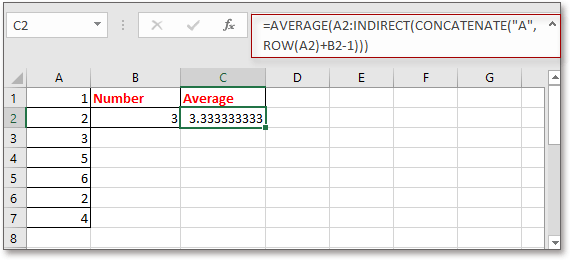Conas raon a shainiú bunaithe ar luach cille eile in Excel?
Is furasta d’fhormhór úsáideoirí Excel raon luachanna a ríomh, ach an ndearna tú iarracht riamh raon luachanna a ríomh bunaithe ar an líon i gcill ar leith? Mar shampla, tá colún luachanna i gcolún A, agus ba mhaith liom líon na luachanna i gcolún A a ríomh bunaithe ar an luach i B2, rud a chiallaíonn má tá sé 4 i B2, meánóidh mé na chéad 4 luach i taispeántar colún A mar atá thíos. Anois tugaim isteach foirmle shimplí chun raon a shainiú go tapa bunaithe ar luach cille eile in Excel.
Sainmhínigh raon bunaithe ar luach cille
 Sainmhínigh raon bunaithe ar luach cille
Sainmhínigh raon bunaithe ar luach cille
Chun ríomh a dhéanamh do raon bunaithe ar luach cille eile, is féidir leat foirmle shimplí a úsáid.
Roghnaigh cill bhán a chuirfidh tú an toradh amach, iontráil an fhoirmle seo = IOMLÁN (A1: INDIRECT (CONCATENATE ("A", B2))), agus brúigh Iontráil eochair chun an toradh a fháil.
1. San fhoirmle, is é A1 an chéad chill sa cholún a theastaíonn uait a ríomh, is é A an colún a ríomhann tú dó, is é B2 an chill a ríomhann tú bunaithe uirthi. Féadfaidh tú na tagairtí seo a athrú de réir mar is gá duit.
2. Más mian leat achoimre a dhéanamh, is féidir leat an fhoirmle seo a úsáid = SUM (A1: INDIRECT (CONCATENATE ("A", B2))).
3. Mura bhfuil na chéad sonraí a theastaíonn uait a shainiú sa chéad tsraith san Excel, mar shampla, i gcill A2, is féidir leat an fhoirmle a úsáid mar seo: = AVERAGE (A2: INDIRECT (CONCATENATE ("A", ROW (A2) + B2-1))).
Líon / Suim cealla go tapa de réir dath cúlra nó formáide in Excel |
| I roinnt cásanna, d’fhéadfadh go mbeadh réimse cealla agat le dathanna iolracha, agus an rud atá uait ná luachanna a chomhaireamh / suim a dhéanamh bunaithe ar an dath céanna, conas is féidir leat a ríomh go tapa? Le Kutools le haghaidh Excel's Líon de réir Dath, is féidir leat go leor ríomhanna a dhéanamh go tapa de réir datha, agus is féidir leat tuairisc ar an toradh ríofa a ghiniúint. Cliceáil le haghaidh trialach iomlán saor in aisce i 30 lá! |
 |
| Kutools for Excel: le níos mó ná 300 breiseán áisiúil Excel, saor in aisce le triail gan aon teorannú i 30 lá. |
Uirlisí Táirgiúlachta Oifige is Fearr
Supercharge Do Scileanna Excel le Kutools le haghaidh Excel, agus Éifeachtúlacht Taithí Cosúil Ná Roimhe. Kutools le haghaidh Excel Tairiscintí Níos mó ná 300 Ardghnéithe chun Táirgiúlacht a Treisiú agus Sábháil Am. Cliceáil anseo chun an ghné is mó a theastaíonn uait a fháil ...

Tugann Tab Oifige comhéadan Tabbed chuig Office, agus Déan Do Obair i bhfad Níos Éasca
- Cumasaigh eagarthóireacht agus léamh tabbed i Word, Excel, PowerPoint, Foilsitheoir, Rochtain, Visio agus Tionscadal.
- Oscail agus cruthaigh cáipéisí iolracha i gcluaisíní nua den fhuinneog chéanna, seachas i bhfuinneoga nua.
- Méadaíonn do tháirgiúlacht 50%, agus laghdaíonn sé na céadta cad a tharlaíonn nuair luch duit gach lá!
